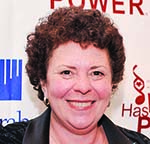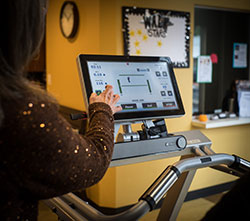- Physical Medicine Home
- Products
- Programs
- Applications
- Find a Clinic
- Blog
- Events
- Education & Training
- In The News
- Press Releases
Physical Medicine Blog
< back to resultsRhythm, Music and Movement for Parkinson’s: Dr. An Interview with Concetta Tomaino
April 23, 2019
The relationship between music and healing has an extensive history, dating back to early civilizations. Today, music interventions are gaining momentum in both research and clinical observation for helping to restore movement in a variety of patient populations.
To understand how music can affect movement in people living with a neurologic disorder like Parkinson’s, we asked an expert. Dr. Concetta Tomaino is the Executive Director and Co-founder of the Institute for Music and Neurologic Function, and has studied music and its effect on neurologic function for close to forty years.
What does research tell us about music and its effect on neurological disorders?
Clinically, we’ve observed for many years that auditory rhythm actually drives motor function. This has been evidenced in people with Parkinson’s, and people with hemiparesis as a result of TBI and stroke. How and why music interventions have been effective has only recently been understood through neuroscience research and investigations.
What we know now is that when sound enters the auditory system, it actually stimulates primary areas of motor function, such as the cerebellum, the motor cortex, and the basal ganglia. Areas like the basal ganglia are affected in people with Parkinson’s. So we know that this auditory pulse, this actual stimulation of neurons in the basal ganglia, gets turned on when someone listens to a musical rhythm.
 |
|
Dr. Concetta Tomaino is the Executive Director and Co-founder of the Institute for Music and Neurologic Function |
We know from clinical observation and also from scientific research that a rhythmic cue can actually influence both the initiation of gait as well as the periodicity of gait, and the ease at which somebody with Parkinson’s can move.
However, because Parkinson’s does affect the basal ganglia and other parts of motor timing, it also affects auditory perception of rhythm. There’s been some research showing that people with Parkinson’s may actually not feel the beat where we think the beat should be. And so, it’s important to have a way of assessing which beat works the best for them, using that beat consistently so that they can move with the same consistency.
Is rhythm the only aspect of music that has an effect on movement in Parkinson’s?
Sometimes it’s not just the beat itself. It may be a certain sound or nuance of the sound that actually stimulates the movement better for one person with Parkinson’s than another.
So, when you are using a music intervention in helping to treat someone with Parkinson’s, it’s important to look at the timbre, like the instrument that’s making the sound, as well as the rhythmic cueing. That assessment process is really crucial to optimizing the type of recovery, in the sense of ease of gait, that we can get with someone with Parkinson’s.
The specific areas of the brain that get stimulated by auditory rhythm are really spread out throughout the brain. It’s the cerebellum, the basal ganglia, the motor cortex, the frontal cortex – all of these areas are tied into the perception of rhythm. The challenge is that when people have Parkinson’s, some of those areas of perception may break down. The person may not feel the beat at the same time that a person without Parkinson’s would feel it.
The question for a therapist is, where is this person feeling the pulse when they listen to music with a rhythmic cue? Once we understand that, we can actually optimize what the cue is going to be, whether it’s an anticipatory beat, whether it’s a different style of rhythm, to really optimize how well they’re going to be able to not only initiate movement, but then to consistently walk over time.
Can you describe a typical gait training session using music?
In order to optimize therapy for a specific patient, we have the patient tap to the rhythm in the tempo of their targeted gait cadence to determine where they perceive the beat, and if they can integrate the beat into their gait pattern. If they do that successfully, we’ll start with that beat when they get onto the treadmill.
Then we’ll see if they can consistently entrain their gait to that beat.
If we want to optimize them at a slightly faster tempo, then we can speed up that tempo in real time as the person is walking using our gait training treadmill. Then, we study them and observe their gait for the next few minutes.
 |
|
Biodex Gait Trainer 3 with Music-Assisted Therapy allows users to engage and observe the effects of various musical elements in real time. |
There’s an envelope of sound in addition to the rhythmic cue that can also enhance stride length as well as posture. Our gait trainer has music composed specifically for this type of treatment built right into the system, so we can engage these music elements in real time.
Couldn’t you just use a patient’s favorite music in therapy?
It’s important to distinguish the benefit of a piece of equipment that has integrated sound technology as different from a person using a treadmill with their own iPod or personal music list. Any personalized music – popular music or whatever they’re listening to – is going to change every two or three minutes.
Each time a song changes, that’s going to change how they walk and how they move. It’s not going to provide a consistent cue. It’s not going to help us regulate and monitor how that cue is effecting their walking.
Having a piece of equipment that provides musical cues designed specifically for treatment of movement disorders gives us the ability to not only provide the necessary cue but also to monitor its effectiveness for that patient, then to modify it to optimize their clinical outcomes.
Can you share something interesting about using music for neurologic rehabilitation?
What’s really fascinating and interesting to observe is when a patient with a movement disorder like Parkinson’s who has an unsteady gait before they approach the treadmill, can instantaneously adapt and change their gait in response to the rhythmic cue.
I think they’re surprised themselves at how easy it is for them to entrain to the rhythm and how consistent their movement becomes while they’re using the treadmill. In fact, there’s some carryover immediately when they step down. This synchrony of movement carries over to their gait afterwards.
Conclusion
Music’s ability to unlock movement has yet to be fully understood, but the difference it can make for patients has been proven through decades of research and clinical observation. Emerging technology, such as the music-enhanced treadmill Dr. Tomaino describes, shows promise that patients with Parkinson’s and other movement disorders can expect to see music-driven interventions being used at more clinics in the near future.
Interested in learning more about using music and music-enhanced technology in treatment of movement disorders? Download our white paper:
| Rehabilitation of Neurologically Affected Gait with Music Enhanced Treadmill |
Category:
Physical Medicine





